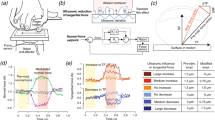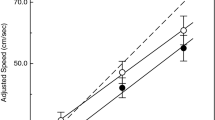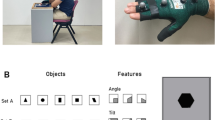Abstract
In our daily activities, we utilize not only the finger pad but also the sides and hemispherical ends of the fingers when handling an object. Therefore, providing tactile perception across the entire fingertip is deemed crucial for achieving advanced teleoperation. To fulfill this goal, understanding the spatial acuity distribution of the fingertip becomes imperative. Although it is generally known that the tactile acuity of the fingertip is different from that at the end of the finger and the finger pad, the details of such a change in resolution are not known, nor is the resolution of the side of the finger. We measured the spatial acuity of the entire fingertip in detail and found that the tactile acuity from the finger end to the finger pad changes almost linearly, with a steep decrease in tactile acuity at the finger side.
Access this chapter
Tax calculation will be finalised at checkout
Purchases are for personal use only
Similar content being viewed by others
References
Culbertson, H., Walker, J.M., Raitor, M., Okamura, A.M.: WAVES: a wearable asymmetric vibration excitation system for presenting three-dimensional translation and rotation cues. In: Proceedings of the 2017 CHI Conference on Human Factors in Computing Systems, pp. 4972–4982. Association for Computing Machinery, New York, NY, USA (2017). https://doi.org/10.1145/3025453.3025741
Kim, H., Yi, H., Lee, H., Lee, W.: HapCube: a wearable tactile device to provide tangential and normal pseudo-force feedback on a fingertip. In: Proceedings of the 2018 CHI Conference on Human Factors in Computing Systems, pp. 1–13. Association for Computing Machinery, New York, NY, USA (2018). https://doi.org/10.1145/3173574.3174075
Kim, H., Kim, M., Lee, W.: HapThimble: a wearable haptic device towards usable virtual touch screen. In: Proceedings of the 2016 CHI Conference on Human Factors in Computing Systems, pp. 3694–3705. Association for Computing Machinery, New York, NY, USA (2016). https://doi.org/10.1145/2858036.2858196
Kim, S.C., et al.: Small and lightweight tactile display (SaLT) and its application. In: World Haptics 2009–Third Joint EuroHaptics Conference and Symposium on Haptic Interfaces for Virtual Environment and Teleoperator Systems, pp. 69–74 (2009). https://doi.org/10.1109/WHC.2009.4810820
Ujitoko, Y., Taniguchi, T., Sakurai, S., Hirota, K.: Development of finger-mounted high-density pin-array haptic display. IEEE Access 8, 145107–145114 (2020). https://doi.org/10.1109/ACCESS.2020.3015058
Shen, V., Rae-Grant, T., Mullenbach, J., Harrison, C., Shultz, C.: Fluid reality: high-resolution, untethered haptic gloves using electroosmotic pump arrays. In: Proceedings of the 36th Annual ACM Symposium on User Interface Software and Technology, pp. 1–20. Association for Computing Machinery, New York, NY, USA (2023). https://doi.org/10.1145/3586183.3606771
Johansson, R.S., Vallbo, A.B.: Tactile sensibility in the human hand: relative and absolute densities of four types of mechanoreceptive units in glabrous skin. J. Physiol. 286, 283–300 (1979). https://doi.org/10.1113/jphysiol.1979.sp012619
Corniani, G., Saal, H.: Tactile innervation densities across the whole body. J. Neurophysiol. 124(4), 1229–1240 (2020)https://doi.org/10.1152/jn.00313.2020
Ross, D.J.M., Helen, E.: E.H Weber on the Tactile Senses. Psychology Press, London (1996)
Johnson, K.O., Phillips, J.R.: Tactile spatial resolution. I. Two-point discrimination, gap detection, grating resolution, and letter recognition. J. Neurophysiol. 46(6), 1177–1192 (1981). https://doi.org/10.1152/jn.1981.46.6.1177
Craig, J.C., Johnson, K.O.: The two-point threshold: not a measure of tactile spatial resolution. curr. Dir. Psychol. Sci. 9, 29–32 (2000). https://doi.org/10.1111/1467-8721.00054
Tong, J., Mao, O., Goldreich, D.: Two-point orientation discrimination versus the traditional two-point test for tactile spatial acuity assessment. Front. Hum. Neurosci. 7, 579 (2013). https://doi.org/10.3389/fnhum.2013.00579
Craig, J.C.: Grating orientation as a measure of tactile spatial acuity. Somatosens. Mot. Res. 16, 197–206 (1999). https://doi.org/10.1080/08990229970456
Wong, M., Peters, R.M., Goldreich, D.: A physical constraint on perceptual learning: tactile spatial acuity improves with training to a limit set by finger size. J. Neurosci. 33, 9345–9352 (2013). https://doi.org/10.1523/JNEUROSCI.0514-13.2013
Wong, M., Hackeman, E., Hurd, C., Goldreich, D.: Short-term visual deprivation does not enhance passive tactile spatial acuity. PLoS ONE 6, e25277 (2011). https://doi.org/10.1371/journal.pone.0025277
Peters, R.M., Hackeman, E., Goldreich, D.: Diminutive digits discern delicate details: fingertip size and the sex difference in tactile spatial acuity. J. Neurosci. 29, 15756–15761 (2009). https://doi.org/10.1523/JNEUROSCI.3684-09.2009
Goldreich, D., Kanics, I.M.: Tactile acuity is enhanced in blindness. J. Neurosci. 23, 3439–3445 (2003). https://doi.org/10.1523/JNEUROSCI.23-08-03439.2003
Essock, E.A., Krebs, W.K., Prather, J.R.: An anisotropy of human tactile sensitivity and its relation to the visual oblique effect. Exp. Brain Res. 91, 520–524 (1992). https://doi.org/10.1007/BF00227848
Garcia-Hernandez, N., Tsagarakis, N.G., Caldwell, D.G.: Feeling through tactile displays: a study on the effect of the array density and size on the discrimination of tactile patterns. IEEE Trans. Haptics 4, 100–110 (2011). https://doi.org/10.1109/TOH.2010.59
Ujitoko, Y., Sakurai, S., Hirota, K.: Influence of sparse contact point and finger penetration in object on shape recognition. IEEE Trans. Haptics 13, 425–435 (2020). https://doi.org/10.1109/TOH.2019.2954882
Löken, L.S., Lundblad, L.C., Elam, M., Olausson, H.W.: Tactile direction discrimination and vibration detection in diabetic neuropathy. Acta Neurol. Scand. 121, 302–308 (2010). https://doi.org/10.1111/j.1600-0404.2009.01282.x
Acknowledgments
This work was supported by JST A-STEP Grant Number JPMJTR23RC and JSPS KAKENHI Grant Number JP20H05957, Japan.
Author information
Authors and Affiliations
Corresponding authors
Editor information
Editors and Affiliations
Rights and permissions
Copyright information
© 2025 The Author(s), under exclusive license to Springer Nature Switzerland AG
About this paper
Cite this paper
Sobue, M., Kato, S., Mizoguchi, I., Kajimoto, H. (2025). Measuring the Distribution of Tactile Acuity at the Fingertips. In: Kajimoto, H., et al. Haptics: Understanding Touch; Technology and Systems; Applications and Interaction. EuroHaptics 2024. Lecture Notes in Computer Science, vol 14769. Springer, Cham. https://doi.org/10.1007/978-3-031-70061-3_2
Download citation
DOI: https://doi.org/10.1007/978-3-031-70061-3_2
Published:
Publisher Name: Springer, Cham
Print ISBN: 978-3-031-70060-6
Online ISBN: 978-3-031-70061-3
eBook Packages: Computer ScienceComputer Science (R0)




